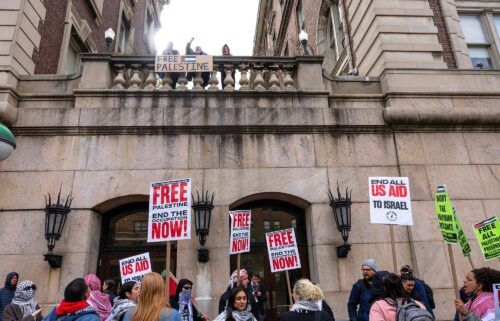How GOP presidents have sought to make Supreme Court history

By Joan Biskupic, CNN legal analyst & Supreme Court biographer
Republican senators who have criticized President Joe Biden‘s pledge to appoint the first Black woman justice are disregarding their own party’s patterns tied to race and the value modern presidents have put on a nominee with broader public appeal.
GOP presidents have at times sought racial minorities for the Supreme Court, understanding the political advantage of appointing an historic “first,” not unlike Biden today.
In 1991, President George H.W. Bush’s legal team considered a Hispanic federal judge in Texas before settling on African American Clarence Thomas to succeed the retiring first Black Justice Thurgood Marshall.
Then when son George W. Bush became president, he tried to position Hispanics and other minorities for elevation to the Supreme Court.
Bush, in fact, might at one time have been able to name the first Black woman justice. In 2003, he nominated Janice Rogers Brown, a California state supreme court judge, to a Washington-based US appellate court long regarded as a steppingstone to the Supreme Court. But Democrats stalled Brown’s nomination for nearly two years and effectively ensured she was shunned in 2005 when Bush had a chance to fill two seats on the high court.
A president’s choice for a lifetime seat on the high court has always meant balancing ideological and political factors with legal credentials. Political payback, public appeal and legacy-making “firsts” inevitably enter the equation.
When Democratic President Lyndon Johnson in 1967 nominated civil rights lawyer Marshall, Johnson said: “He is the best qualified by training and by very valuable service to the country. I believe it is the right thing to do, the right time to do it, the right man and the right place.”
Marshall, an NAACP Legal Defense Fund lawyer who developed the strategy behind the landmark Brown v. Board of Education decision, had become a federal appellate court judge and US solicitor general before his elevation to the Supreme Court.
When Marshall retired in 1991 and the first President Bush selected Thomas, Bush said, “I kept my word to the American people and to the Senate by picking the best man for the job on the merits. And the fact that he’s a minority, so much the better.”
Top aides to Bush said at the time the president focused at the outset on a racial minority.
“We knew, even though it was not articulated, that the president wanted a minority,” Dick Thornburgh, who was attorney general to the first President Bush, said in a 2011 interview. “The odds-on choice was Clarence Thomas.”
Bush had named Thomas to the DC Circuit in 1990. US appellate court Judge Emilio Garza, the son of Mexican immigrants, also made Bush’s short list during the 1991 Supreme Court search, as some Bush aides pressed the possibility of a groundbreaking Hispanic justice.
Such ethnic and racial considerations have been subtly conveyed through the years. Biden, on the other hand, was blunt during the 2020 campaign when he pledged to appoint the first Black woman in the court’s now 233-year history. (US House Whip James Clyburn urged him to make that vow at a February 2020 campaign rally in Clyburn’s home state of South Carolina.)
Some Republicans have criticized Biden for his candid emphasis.
“I believe that diversity benefits the Supreme Court,” Maine Republican Sen. Susan Collins said on ABC’s “This Week” on January 30. “But the way that the President has handled this nomination has been clumsy at best.” Mississippi Republican Sen. Roger Wicker said in an interview with a local radio network that Biden’s nominee would be “the beneficiary” of an affirmative action “quota.”
But such comments ignore the qualifications of the Biden short-listers, as well as the history of their own party.
Many commentators have recalled Ronald Reagan’s campaign vow to appoint the first woman justice, which he fulfilled in 1981 with Sandra Day O’Connor, then a judge on an intermediate Arizona court.
But Reagan also was inspired by ethnic diversity in 1986 when he chose Antonin Scalia over Robert Bork (both DC Circuit judges at the time) because Scalia offered the President the chance to name the first Italian American justice.
The Reagan team, along with senators of both parties, embraced Scalia’s heritage to the point that during his Senate confirmation hearings, Democratic Alabama Sen. Howell Helfin said, “I believe that almost every senator that has an Italian American connection has come forward to welcome you … . I would be remiss if I did not mention the fact that my great-great-grandfather married a widow who was married first to an Italian American.”
Scalia rejoined, “Senator, I have been to Alabama several times, too.”
In 1987, Reagan tapped Bork, but his more extensive and controversial right-wing record made him a larger target.
The Democratic-controlled Senate voted him down, 58-42.
Search for the first Hispanic
Against the backdrop of the country’s burgeoning Hispanic population, presidents of both parties accelerated efforts to diversify judicial nominations.
In 1997, Democrat Bill Clinton nominated Sonia Sotomayor, a federal trial judge with Puerto Rican roots, to a New York-based US appellate court.
The move was widely viewed as putting Sotomayor on deck for elevation to the Supreme Court. A diverse coalition of Hispanic advocacy groups backed Sotomayor, but Republicans delayed a floor vote for months.
Sotomayor’s supporters were able to secure a floor vote in October 1998, only with help from New York Republican Sen. Alfonse D’Amato, running for reelection and hoping to win over Hispanic voters. (Sotomayor was confirmed 67-29; D’Amato ended up losing a month later to then-Democratic Rep. Chuck Schumer, now the majority leader.)
In 2001, Texas native George W. Bush entered office with a priority that reflected his home state’s large Hispanic population.
“It has always been important to him,” Belmont University law school dean Alberto Gonzales, who was Bush’s White House counsel and attorney general, said in a recent interview.
Gonzales, also a Texan, said that when then-Gov. Bush named him to the state supreme court in 1998, reporters asked if Gonzales was selected for his Mexican-American heritage.
Bush answered, Gonzales recalled, by saying, “Of course, it made a difference. But the number one priority was whether this was someone who could do the job.”
As president in 2001, Bush nominated Washington lawyer Miguel Estrada, who had immigrated from Honduras as a child and become a prominent appellate attorney, to the DC Circuit.
“Miguel had lots of supporters on my team,” Gonzales said. “It was a way to put someone in the pipeline who would potentially have the credentials to be confirmed by the Senate.”
Democratic senators blocked Estrada, whose record of conservatism triggered divisions in the Hispanic community. He faced multiple Senate filibusters and finally withdrew his name in September 2003.
If Estrada had made it onto the prominent DC Circuit, he might have been tapped in 2005 for Supreme Court vacancies that emerged. O’Connor announced her retirement and then Chief Justice William Rehnquist died.
Bush interviewed no Hispanic candidate for the spots that year, and eventually federal appellate judges John Roberts and Samuel Alito were selected, Roberts to be chief justice and Alito to fill O’Connor’s seat.
Gonzales himself was regarded as a possible Supreme Court appointee in Bush’s early tenure, but by 2005, in part because of some moderate stances he took, Gonzales was not a contender.
Bush had pushed the nomination of Janice Rogers Brown for the DC Circuit beginning in 2003. But Brown’s conservative record from the California Supreme Court, particularly on civil rights issues, made her a divisive figure.
Leading Democrats, including then-Sen. Biden opposed Brown, and she gained confirmation for the DC Circuit appellate seat, 56-43, only in June 2005, just weeks before the Supreme Court openings emerged. Bush declined to interview her for the Supreme Court.
President Barack Obama, who succeeded Bush, used the first Supreme Court vacancy of his tenure to select Latina Sotomayor. “She’s faced down barriers, overcome the odds, lived out the American dream that brought her parents here so long ago,” Obama said as he announced the nomination of the first Hispanic justice in 2009.
Democrats embraced his choice, and she won the votes of nine Republican for a final tally of 68-31. But one Republican senator who supported Sotomayor could not help but recall that a Republican president might have made that historic “first.”
“No Republican would have chosen you, Judge,” Lindsey Graham of South Carolina said during Senate Judiciary Committee hearings. “That is just the way it is. We would have picked Miguel Estrada. We would all have voted for him.”
The-CNN-Wire
™ & © 2022 Cable News Network, Inc., a WarnerMedia Company. All rights reserved.


